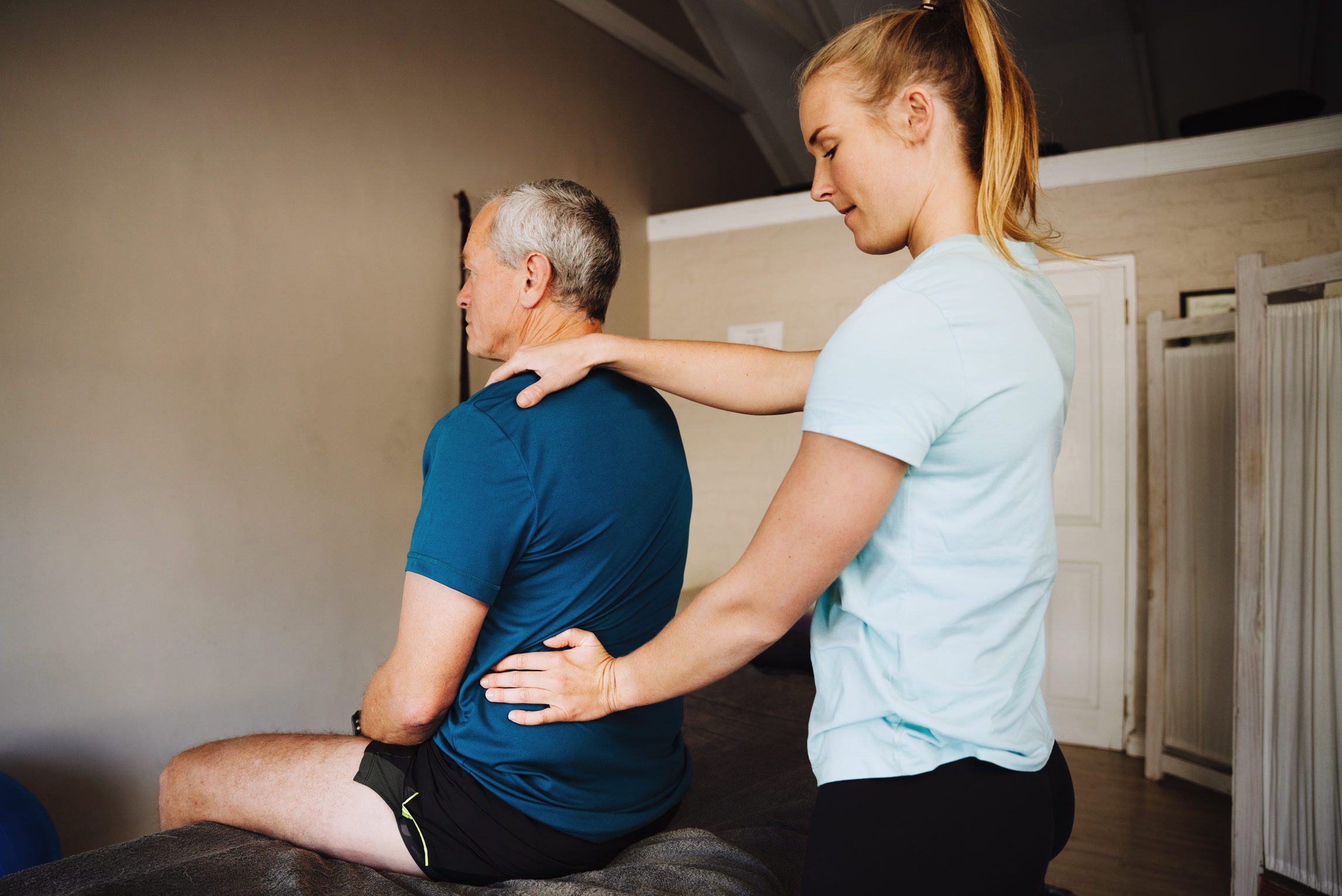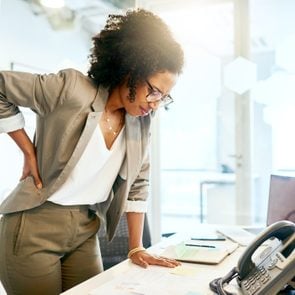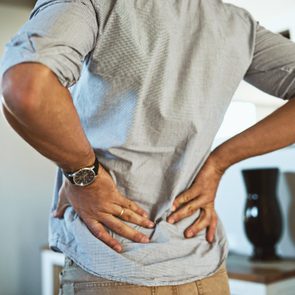16 Ways to Get Rid of Lower Back Pain for Good
Updated: Apr. 05, 2021
Got low back pain? Try these expert-approved treatments, from NSAIDs to physical therapy, to get rid of your lower back pain for good.
Our editors and experts handpick every product we feature. We may earn a commission from your purchases.
Understanding lower back pain
Low back pain can do more than keep you from the activities and people you love, it can also rob you of your quality of life and ability to get a good night’s rest.
And you are not alone. Up to 80 percent of people will experience back pain during the course of their lives. Back pain is the most common reason for missed work and the third most frequent reason people visit the doctor’s office, according to the American Chiropractic Association. (Here are more surprising reasons for back pain.)
Your back is made up of bones (vertebrae), muscles, joints ligaments, nerves, and intervertebral discs, all of which can drive back pain if they become damaged or misaligned. This can occur due to advancing age, trauma, overexertion, or underlying disease, among other causes. Back pain is common across both genders, but there are some causes that are unique to women. (Here are the causes of lower back pain in women.)
How to get rid of lower back pain
“Many times, low back pain can be self-limiting, and it is not generally a cause for concern,” says Jake Magel, a physical therapist and research assistant professor at the University of Utah in Salt Lake City. “Most of the time, this pain will resolve within six weeks, but there are many things to try to help you get relief sooner.”
Treatments for lower back pain range from over-the-counter pain (OTC) medications to physical therapy. Other times, lower back pain may warrant surgery. You always want to consult with your doctor to make sure you follow the best course of action for your condition.
Here’s what you need to know about the various ways to treat lower back pain.
NSAIDs or OTC painkillers
Non-steroidal anti-inflammatory drugs (NSAIDs) such as naproxen and ibuprofen can help cool inflammation and reduce back pain. Prescription-strength NSAIDs and topical gels or ointments are also available. Other pain-relieving options include acetaminophen and aspirin.
Recommended for: Most types of back pain (including strains and sprains), osteoarthritis, disc injury, and spinal stenosis, a condition that occurs when the space around your spinal cord narrows and puts pressure on the cord and your spinal nerves.
Risks: NSAIDs can be harsh on your stomach, cautions the American Academy of Orthopaedic Surgeons. Always follow the dosing instructions on the label to minimize any side effects and ask your doctor about adding acid reflux medication. These are the hidden dangers of common OTC pain relievers.
Narcotics
If NSAIDs or acetaminophen aren’t doing the trick for your low back pain, your doctor may suggest stronger prescription painkillers (narcotics), such as codeine or morphine. These are also known as opioids.
Recommended for: Severe pain that does not respond to other medications.
Risks: These are highly addictive and should never be used without a prescription or for long periods of time, cautions the Agency for Healthcare Research and Quality. As many as one in four people receiving long-term opioid therapy struggle with opioid addiction, according to the Centers for Disease Control and Prevention.
Muscle relaxants
Prescription muscle relaxants may also relieve some types of low back pain. These are often taken with OTC pain relievers to relax tense muscles and reduce pain, according to the Agency for Healthcare Research and Quality.
Recommended for: Low back pain that doesn’t respond to OTC treatment.
Risks: Muscle relaxants may leave you feeling drowsy and dizzy.
Antidepressants
Antidepressants may play a role in treating low back pain. These drugs boost levels of feel-good brain chemicals that can affect how you perceive pain.
Recommended for: Chronic or long-lasting back pain. A recent review study, published last month in BMJ, suggests that antidepressants may be helpful for osteoarthritis and sciatica, the latter of which results from a damaged nerve in the lower back and produces radiating pain down your leg. Here’s the caveat: The pain reduction was seen only in the short term. None of the studies analyzed in the review looked at osteoarthritis or sciatica pain relief past the one-year mark. (Learn more about sciatica symptoms.)
Warnings: Side effects may include nausea, dry mouth, or fatigue, among others
Anticonvulsants
There was some evidence suggesting that anticonvulsants used to treat seizure disorders like epilepsy can help relieve back pain, but a review study throws sand on this theory. It found that anticonvulsants weren’t effective in easing low back pain or nerve pain shooting down the leg due to back problems. The study appears in a 2018 issue of the Canadian Medical Association Journal.
Risks: Side effects may include weight changes, upset stomach, depression, and headaches, among others.

Physical therapy
Physical therapists like Magel have lots of tools and tricks up their sleeves. “We develop a treatment plan to match the signs and symptoms of your back pain, and this can include spinal manipulation, exercise, and education about pain,” he says.
Treatment centers on specific stretching exercises that will help you build the muscles that support the spine and improve flexibility and range of motion. (These are the types of exercises for lower back pain.)
Yoga, tai chi, and Pilates all involve gentle stretching and can also keep you limber, says Jordan D. Metzl, MD, a sports medicine physician at the Hospital for Special Surgery in New York City and author of several books including Dr. Jordan Metzl’s Running Strong: The Sports Doctor’s Complete Guide to Staying Healthy and Injury-Free for Life.
Some physical therapists offer manipulation, a hands-on treatment that applies short and rapid thrusting movements to a joint while the body is in a specific position.
Physical therapy programs and protocols may also include foam rolling, adds Metzl. (Here’s how to use a foam roller for back pain.)
Recommended for: Most types of back pain.
Risks: If you work with a qualified physical therapist and follow the instructions, physical therapy is extremely low risk.
Heat and ice
Applying heat and/or ice to your low back may improve your pain.
Recommended for: Most types of back pain. In general, use ice for the first 48 to 72 hours, then use heat.
Risks: High temperatures can cause burns. Be careful. (Learn more about when to apply ice vs. heat for pain.)
Steroid injections
Steroid injections can cool inflammation in your lower back, and the results may last for up to three months.
Recommended for: People who have tried OTC or prescription pain medication for at least six weeks but haven’t found relief, says Krishna Shah, MD, assistant professor, of anesthesiology and interventional pain medicine at Baylor College of Medicine in Houston. Steroid injections can help with arthritis, disc-related pain, spinal stenosis, and most other types of low back pain, he says.
Risks: Shah warns that spinal injections can cause debilitating spinal headaches and muscle weakness in the area.
Weight loss
If you are overweight or obese, you are more likely to have low back pain. Weight loss can take some physical stress off of your back and reduce pain, Dr. Metzl says.
Recommended for: Everyone who has weight to lose.
Risks: None
Stress relief
Stress makes everything worse—including your back pain, says Dr. Metzl. Stress relief such as deep breathing, mindfulness, meditation, and anything else that helps you wind down will have spillover benefits on your back pain. (Try these stress-management tips.)
Recommended for: Everyone
Risks: None
Better sleep
A poor night’s sleep and a poor sleep position could wreak havoc on your back and trigger back pain. According to the Sleep Foundation, if you don’t have a proper mattress that offers back support, you can develop lower back pain or worsen pain you already have. A good mattress will not only help your back but also improve your sleep quality. (These are the best mattresses for lower back pain.)
Recommended for: Everyone
Risks: None
Cognitive-behavioral therapy
Cognitive-behavioral therapy (CBT) is a time-limited course of talk therapy that helps you change how you cope with your back pain, according to Medline Plus.
Recommended for: Chronic low pain that is getting in the way of you doing the things that you need and want to do.
Risks: None
Better shoes
Lower back pain can be induced by improper footwear. For example, wearing high heels can affect your alignment and throw off your center of gravity. When you wear heels, you tend to put more pressure on your feet, which doesn’t allow you to extend your calf. This puts stress and strain on your lower back.
On the opposite end, frequently wearing flip-flops without proper arch support can lead to arch pain and trigger pain throughout the body, including the lower back. (These are the best flip-flops with arch support.)
Recommended for: Everyone
Risks: None
Antibiotics
If your back pain is caused by an infection in your spine or one that has traveled to your spine from somewhere else in your body, antibiotics, which are often given in the hospital, are needed.
Recommended for: Spinal infections. Other signs may include fever and warmness on the back. Surgery may also be needed in these cases, notes Nikhil Jain, MD, a fellow in the Department of Neurosurgery at the University of Louisville in Kentucky.
Risks: Taken properly under a doctor’s supervision, antibiotics don’t pose a risk—but spinal infections do. They’re potentially deadly.
Kyphoplasty/Vertebroplasty
If you have a fractured vertebra, your doctor may order these types of surgery to reduce pain and restore mobility. Kyphoplasty is a minimally invasive surgery, during which your doctor will insert a needle into the fractured area with an X-ray as guidance. Your doctor will then inflate a balloon-like device to make space and fill it with bone cement to restore height and reduce pain, according to the American Academy of Orthopaedic Surgeons. Vertebroplasty is a similar procedure that injects bone cement directly into the area without the balloon device.
Recommended for: These procedures can help when fractures are causing your low back pain, including those that occur as a result of the brittle bone disease osteoporosis.
Risks: Potential risks include infection, bleeding, numbness, tingling, and worsening pain.
(Find out if a brace for lower back pain can help you find relief.)
Spine surgery
Spine surgery is the last resort for most types of back pain, says Dr. Jain. “Surgery is only considering after at least six weeks of comprehensive conservative management, including activity modification, physical therapy, anti-inflammatory drugs, and/or muscle relaxant medications and injections,” he says.
There are many different types of back surgery. Spinal fusion, for example, joins two or more vertebrae together so they heal into a single bone. By contrast, lumbar microdiscectomy removes the herniated part of the disc and any fragments that are putting pressure on your spinal nerve.
Recommended for: Surgery may be considered if there is “loss of muscle power in extremities, significant numbness, or loss of bowel and/or bladder function due to compression of nerves,” Dr. Jain says.
(These are the everyday habits damaging your spine.)
The last word
Your first step toward low back pain relief is to see your doctor to find out what is causing your pain. Your doctor will likely conduct a physical exam and order imaging tests to determine the cause. This will help better match treatment to your specific back pain. If your pain doesn’t improve with OTC painkillers, physical therapy, or other measures within six weeks, you may need to consider more aggressive measures.
Next, learn how to tell when your back pain is an emergency.























